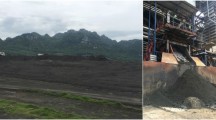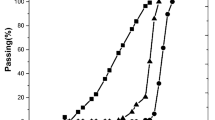Abstract
Coal combustion waste reaches huge amount that causes environmental problem. In modern world, wastes generated from an industry can be used by another industry as raw material. Bottom ash, a coal combustion waste, has found less usage area compared to fly ash in cement and concrete areas. Concrete paving block can be a good material to recycle bottom ash. Experimental works were fulfilled to investigate influences of recycling bottom ash in production of concrete paving blocks in this study. Three bottom ashes obtained from different coal burning plants were used. Elemental analysis, mineral characterization, and particle morphology of bottom ashes were determined by XRF, XRD, and SEM analyses, respectively. In production of blocks, cement was substituted with bottom ashes at 10%, 20%, and 30%. Unit weight, absorption, freeze–thaw, abrasion, and leaching tests were performed on specimens. Splitting tensile and compressive strength tests were also performed to determine the mechanical properties of the paving block. It can be concluded that bottom ashes can be used up to 20% replacement ratio in production of concrete paving blocks. It is also emphasized that freezing and thawing, and wear resistant concrete paving clocks can be obtained, even using bottom ash waste.




















Similar content being viewed by others
References
Gencel O, Ozel C, Koksal F, Erdogmus E, Martínez-Barrera G, Brostow W (2012) Properties of concrete paving blocks made with waste marble. J Clean Prod 21:62–70. https://doi.org/10.1016/j.jclepro.2011.08.023
Jamshidi A, Kurumisawa K, White G, Nishizawa T, Igarashi T, Nawa T, Mao J (2019) State-of-the-art of interlocking concrete block pavement technology in Japan as a post-modern pavement. Constr Build Mater 200:713–755. https://doi.org/10.1016/j.conbuildmat.2018.11.286
Meng Y, Ling TC, Mo KH (2018) Recycling of wastes for value-added applications in concrete blocks: an overview. Resour Conserv Recycl 138:298–312. https://doi.org/10.1016/j.resconrec.2018.07.029
Jankovic K, Nikolic D, Bojovic D (2012) Concrete paving blocks and flags made with crushed brick as aggregate. Constr Build Mater 28:659–663. https://doi.org/10.1016/j.conbuildmat.2011.10.036
Wattanasiriwech D, Saiton A, Wattanasiriwech S (2009) Paving blocks from ceramic tile production waste. J Clean Prod 17:1663–1668. https://doi.org/10.1016/j.jclepro.2009.08.008
Poon CS, Chan D (2007) Effects of contaminants on the properties of concrete paving blocks prepared with recycled concrete aggregates. Constr Build Mater 21:164–175. https://doi.org/10.1016/j.conbuildmat.2005.06.031
Agyeman S, Obeng-Ahenkora NK, Assiamah S, Twumasi G (2019) Exploiting recycled plastic waste as an alternative binder for paving blocks production. Case Stud Constr Mater. https://doi.org/10.1016/j.cscm.2019.e00246
Atici U, Ersoy A (2008) Evaluation of destruction specific energy of fly ash and slag admixed concrete interlocking paving blocks (CIPB). Constr Build Mater 22:1507–1514. https://doi.org/10.1016/j.conbuildmat.2007.03.028
Sadek DM, El Nouhy HA (2014) Properties of paving units incorporating crushed ceramic. HBRC J 10:198–205. https://doi.org/10.1016/j.hbrcj.2013.11.006
Wang L, Yeung TLK, Lau AYT, Tsang DCW, Poon CS (2017) Recycling contaminated sediment into eco-friendly paving blocks by a combination of binary cement and carbon dioxide curing. J Clean Prod 164:1279–1288. https://doi.org/10.1016/j.jclepro.2017.07.070
Sojobi AO, Aladegboye OJ, Awolusi TF (2018) Green interlocking paving units. Constr Build Mater 173:600–614. https://doi.org/10.1016/j.conbuildmat.2018.04.061
Ganjian E, Jalull G, Sadeghi-Pouya H (2015) Using waste materials and by-products to produce concrete paving blocks. Constr Build Mater 77:270–275. https://doi.org/10.1016/j.conbuildmat.2014.12.048
Da Silva FM, Gachet-Barbosa LA, Lintz RCC, Jacintho AEPGA (2015) Investigation on the properties of concrete tactile paving blocks made with recycled tire rubber. Constr Build Mater 91:71–79. https://doi.org/10.1016/j.conbuildmat.2015.05.027
Limbachiya V, Ganjian E, Claisse P (2016) Strength, durability and leaching properties of concrete paving blocks incorporating GGBS and SF. Constr Build Mater 113:273–279. https://doi.org/10.1016/j.conbuildmat.2016.02.152
Soutsos MN, Tang K, Millard SG (2011) Use of recycled demolition aggregate in precast products, phase II: concrete paving blocks. Constr Build Mater 25:3131–3143. https://doi.org/10.1016/j.conbuildmat.2010.12.024
Mashaly AO, El-Kaliouby BA, Shalaby BN, El-Gohary AM, Rashwan MA (2016) Effects of marble sludge incorporation on the properties of cement composites and concrete paving blocks. J Clean Prod 112:731–741. https://doi.org/10.1016/j.jclepro.2015.07.023
Uygunolu T, Topcu IB, Gencel O, Brostow W (2012) The effect of fly ash content and types of aggregates on the properties of pre-fabricated concrete interlocking blocks (PCIBs). Constr Build Mater 30:180–187. https://doi.org/10.1016/j.conbuildmat.2011.12.020
Evangelista BL, Rosado LP, Penteado CSG (2018) Life cycle assessment of concrete paving blocks using electric arc furnace slag as natural coarse aggregate substitute. J Clean Prod 178:176–185. https://doi.org/10.1016/j.jclepro.2018.01.007
Sadek DM, El-Attar MM, Ali AM (2017) Physico-mechanical and durability characteristics of concrete paving blocks incorporating cement kiln dust. Constr Build Mater 157:300–312. https://doi.org/10.1016/j.conbuildmat.2017.09.107
Said I, Missaoui A, Lafhaj Z (2015) Reuse of Tunisian marine sediments in paving blocks: factory scale experiment. J Clean Prod 102:66–77. https://doi.org/10.1016/j.jclepro.2015.04.138
Wang L, Chen L, Tsang DCW, Li JS, Baek K, Hou D, Ding S, Poon CS (2018) Recycling dredged sediment into fill materials, partition blocks, and paving blocks: technical and economic assessment. J Clean Prod 199:69–76. https://doi.org/10.1016/j.jclepro.2018.07.165
Xuan D, Zhan B, Poon CS (2016) Development of a new generation of eco-friendly concrete blocks by accelerated mineral carbonation. J Clean Prod 133:1235–1241. https://doi.org/10.1016/j.jclepro.2016.06.062
Haque MA (2016) Assessment of nickel leaching phenomena from landfill waste mixed paving block for eco-friendly field application. J Clean Prod 139:99–112. https://doi.org/10.1016/j.jclepro.2016.08.028
Ling TC, Poon CS (2014) Use of recycled CRT funnel glass as fine aggregate in dry-mixed concrete paving blocks. J Clean Prod 68:209–215. https://doi.org/10.1016/j.jclepro.2013.12.084
World Coal Association. https://sustainabledevelopment.un.org/getWSDoc.php?id=996#:~:text=Coal%20currently%20supplies%20around%2030,to%20meet%20improved%20electrification%20rates. Accessed 08 Jan 2021
Vinai R, Lawane A, Minane JR, Amadou A (2013) Coal combustion residues valorisation: research and development on compressed brick production. Constr Build Mater 40:1088–1096. https://doi.org/10.1016/j.conbuildmat.2012.11.096
Harris D, Heidrich C, Feuerborn J (2020) Global aspects on coal combustion products. VGB Power Tech. <https://www.vgb.org/vgbmultimedia/PT202010HARRIS-p-16422.pdf. Accessed 22 Jan 2021
Munawer ME (2018) Human health and environmental impacts of coal combustion and post-combustion wastes. J Sustain Min 17:87–96. https://doi.org/10.1016/j.jsm.2017.12.007
Bilir T, Gencel O, Topcu IB (2015) Properties of mortars with fly ash as fine aggregate. Constr Build Mater 93:782–789. https://doi.org/10.1016/j.conbuildmat.2015.05.095
Bilir T, Yüksel I, Topcu IB, Gencel O (2017) Effects of bottom ash and granulated blast furnace slag as fine aggregate on abrasion resistance of concrete. Sci Eng Compos Mater 24:261–269. https://doi.org/10.1515/secm-2015-0101
Siddique R (2015) Kunal, Design and development of self-compacting concrete made with coal bottom ash. J Sustain Cem Mater 4:225–237. https://doi.org/10.1080/21650373.2015.1004138
Siddique R (2010) Utilization of coal combustion by-products in sustainable construction materials. Resour Conserv Recycl 54:1060–1066. https://doi.org/10.1016/j.resconrec.2010.06.011
Kim GM, Jang JG, Khalid HR, Lee HK (2017) Water purification characteristics of pervious concrete fabricated with CSA cement and bottom ash aggregates. Constr Build Mater 136:1–8. https://doi.org/10.1016/j.conbuildmat.2017.01.020
Abdulmatin A, Tangchirapat W, Jaturapitakkul C (2018) An investigation of bottom ash as a pozzolanic material. Constr Build Mater 186:155–162. https://doi.org/10.1016/j.conbuildmat.2018.07.101
Sutcu M, Erdogmus E, Gencel O, Gholampour A, Atan E, Ozbakkaloglu T (2019) Recycling of bottom ash and fly ash wastes in eco-friendly clay brick production. J Clean Prod 233:753–764. https://doi.org/10.1016/j.jclepro.2019.06.017
Ghafoori N, Mathis R (1998) Prediction of freezing and thawing durability of concrete paving blocks. J Mater Civ Eng 10:45–51. https://doi.org/10.1061/(ASCE)0899-1561(1998)10:1(45)
Ling TC (2012) Effects of compaction method and rubber content on the properties of concrete paving blocks. Constr Build Mater 28:164–175. https://doi.org/10.1016/j.conbuildmat.2011.08.069
Galetakis M, Alevizos G, Leventakis K (2012) Evaluation of fine limestone quarry by-products, for the production of building elements—an experimental approach. Constr Build Mater 26:122–130. https://doi.org/10.1016/j.conbuildmat.2011.05.011
Cheriaf M, Rocha JC, Péra J (1999) Pozzolanic properties of pulverized coal combustion bottom ash. Cem Concr Res 29:1387–1391. https://doi.org/10.1016/S0008-8846(99)00098-8
Jaturapitakkul C, Cheerarot R (2003) Development of bottom ash as pozzolanic material. J Mater Civ Eng 15:48–53. https://doi.org/10.1061/(ASCE)0899-1561(2003)15:1(48)
Oruji S, Brake NA, Nalluri L, Guduru RK (2017) Strength activity and microstructure of blended ultra-fine coal bottom ash-cement mortar. Constr Build Mater 153:317–326. https://doi.org/10.1016/j.conbuildmat.2017.07.088
Khan MI, Lynsdale CJ, Waldron P (2000) Porosity and strength of PFA/SF/OPC ternary blended paste. Cem Concr Res 30:1225–1229. https://doi.org/10.1016/S0008-8846(00)00307-0
El Nouhy HA (2013) Properties of paving units incorporating slag cement. HBRC J 9:41–48. https://doi.org/10.1016/j.hbrcj.2012.12.004
Poon CS, Lam L, Wong YL (1999) Effects of fly ash and silica fume on interfacial porosity of concrete. J Mater Civ Eng 11:197–205. https://doi.org/10.1061/(ASCE)0899-1561(1999)11:3(197)
Clavier KA, Watts B, Liu Y, Ferraro CC, Townsend TG (2019) Risk and performance assessment of cement made using municipal solid waste incinerator bottom ash as a cement kiln feed. Resour Conserv Recycl. https://doi.org/10.1016/j.resconrec.2019.03.047
Wu MH, Huang WC, Lin CL, Chen JW (2015) Heavy metals leaching from the incinerator bottom ash used for road pavement. J Residuals Sci Technol 12:S11–S15. https://doi.org/10.12783/issn.1544-8053/12/S1/2
Arioglu N, Canan-Girgin Z, Arioglu E (2006) Evaluation of ratio between splitting tensile strength and compressive strength for concretes up to 120 MPa and its application in strength criterion. ACI Mater J 103:18–24. https://doi.org/10.14359/15123
Oluokun FA (1991) Prediction of concrete tensile strength from its compressive strength. Evaluation of existing relations for normal weight concrete. ACI Mater J 88:302–309. https://doi.org/10.14359/1942
Carino NJ, Lew HS (1982) Re-examination of the relation between splitting tensile and compressive strength of normal weight concrete. J Am Concr Inst 79:214–219. https://doi.org/10.14359/10900
Raphael JM (1984) Tensile strength of concrete. J Am Concr Inst 81:158–165. https://doi.org/10.1007/978-3-642-41714-6_200519
Shah SP, Ahmad SH (1985) Structural properties of high strength concrete and its implications for precast prestressed concrete. J Prestress Concr Inst 30:92–119. https://doi.org/10.15554/pcij.11011985.92.119
Choi Y, Yuan RL (2005) Experimental relationship between splitting tensile strength and compressive strength of GFRC and PFRC. Cem Concr Res 35:1587–1591. https://doi.org/10.1016/j.cemconres.2004.09.010
Xu BW, Shi HS (2009) Correlations among mechanical properties of steel fiber reinforced concrete. Constr Build Mater 23:3468–3474. https://doi.org/10.1016/j.conbuildmat.2009.08.017
Gencel O, Koksal F, Ozel C, Brostow W (2012) Combined effects of fly ash and waste ferrochromium on properties of concrete. Constr Build Mater 29:633–640. https://doi.org/10.1016/j.conbuildmat.2011.11.026
CFR (Code of Federal Regulations) (2012) Section 261.24–toxicity characteristics. 40. US Government Printing Office
IWRG 631 (Industrial Waste Resource Guidelines) (2009) Solid ındustrial waste hazard categorization and management. Environment Protection Authority, Victoria
Author information
Authors and Affiliations
Corresponding author
Additional information
Publisher's Note
Springer Nature remains neutral with regard to jurisdictional claims in published maps and institutional affiliations.
Rights and permissions
About this article
Cite this article
Koksal, F., Gencel, O., Sahin, Y. et al. Recycling bottom ash in production of eco-friendly interlocking concrete paving blocks. J Mater Cycles Waste Manag 23, 985–1001 (2021). https://doi.org/10.1007/s10163-021-01186-8
Received:
Accepted:
Published:
Issue Date:
DOI: https://doi.org/10.1007/s10163-021-01186-8




